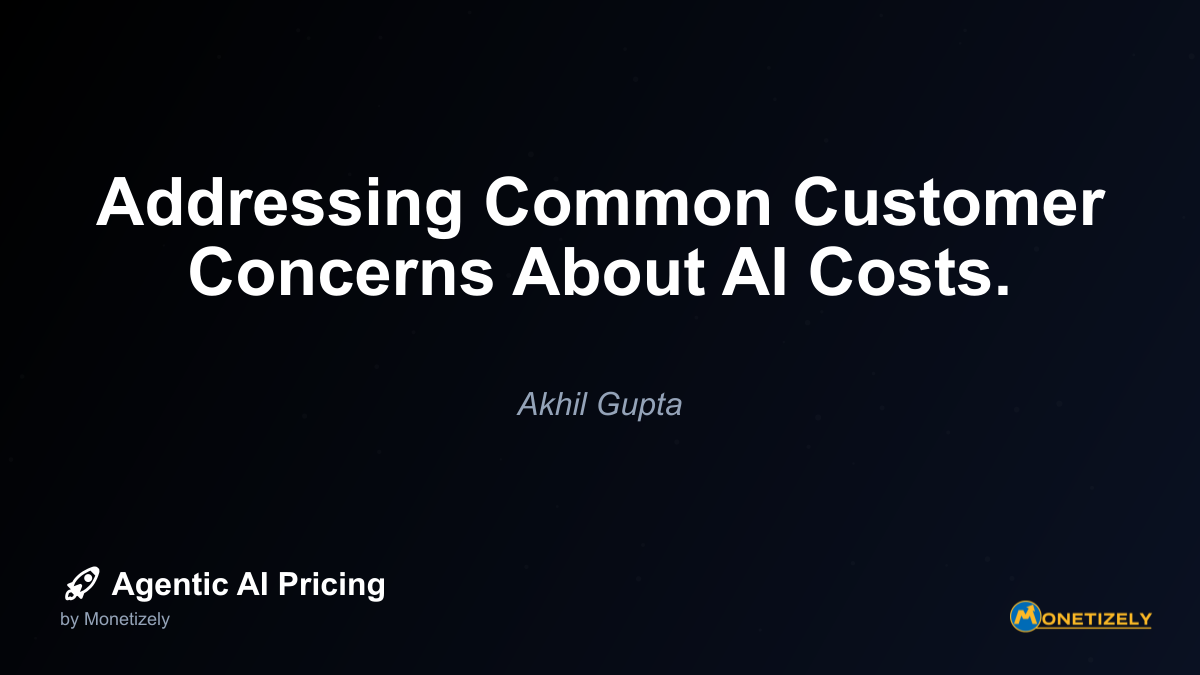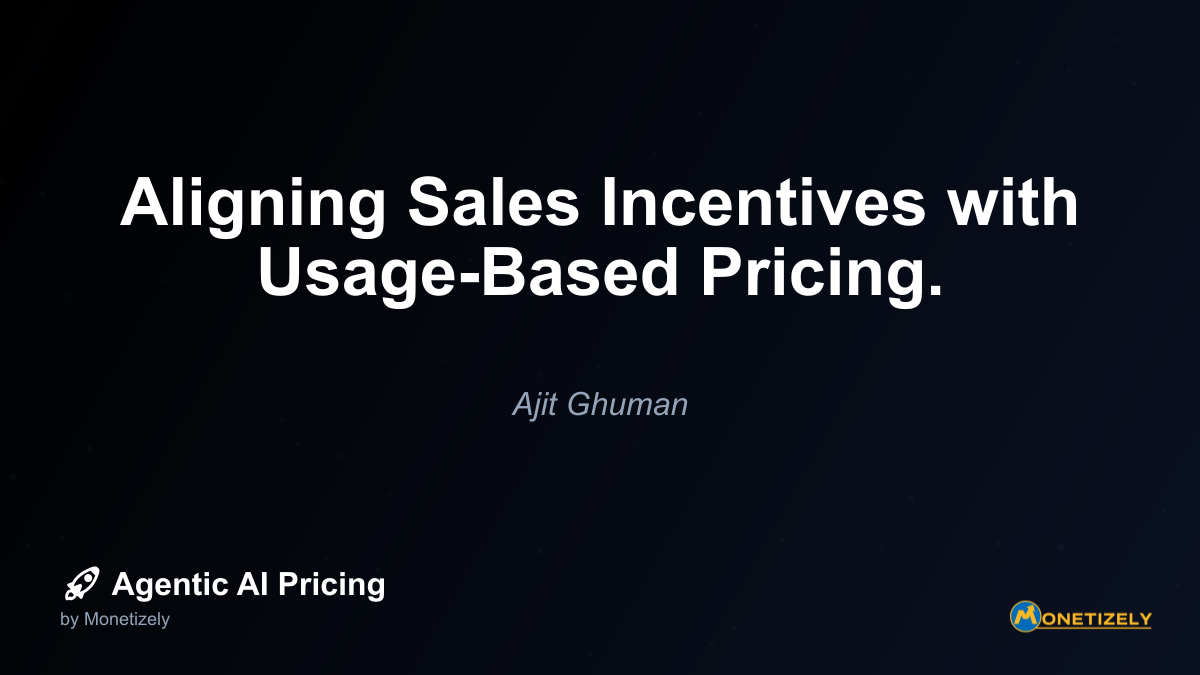· Akhil Gupta · Best Practices · 8 min read
Handling Unpredictable AI Usage Patterns.
AI and SaaS Pricing Masterclass
Learn the art of strategic pricing directly from industry experts. Our comprehensive course provides frameworks and methodologies for optimizing your pricing strategy in the evolving AI landscape. Earn a professional certification that can be imported directly to your LinkedIn profile.

Key Factors Driving Unpredictable AI Usage
To develop effective strategies for managing usage variability, we must first understand the root causes:
1. User Behavior and Adoption Patterns
Organizations adopting AI solutions typically go through several phases that impact usage:
- Experimentation: Initial cautious testing with limited usage
- Expansion: Rapid growth as successful use cases are identified
- Integration: Embedding AI capabilities into workflows, often causing usage spikes
- Optimization: Refinement of processes to balance cost and value
Each phase creates different usage patterns, making forecasting difficult for both vendors and customers.
2. Application-Specific Factors
Different AI applications inherently create different usage profiles:
- Customer-facing applications: Usage tied to end-user engagement, which may follow daily, weekly, or seasonal patterns
- Internal process automation: Often batch-oriented with predictable but intense processing periods
- Decision support systems: Typically event-driven with bursts of activity around key decisions
- Continuous monitoring systems: Steady baseline with occasional spikes during anomalous events
3. External Drivers
Many factors outside direct control influence AI usage:
- Market conditions: Economic shifts can dramatically alter AI utilization
- Competitive pressures: Strategic responses to market changes often drive rapid AI adoption
- Regulatory changes: New compliance requirements may necessitate immediate AI-powered analysis
- Black swan events: Pandemics, natural disasters, or major disruptions create unpredictable usage needs
The Business Impact of Unpredictable Usage
Unpredictable AI usage creates challenges for both vendors and customers:
For AI Service Providers:
- Infrastructure provisioning: Maintaining excess capacity for peak demands is costly
- Revenue forecasting: Unpredictable usage makes financial planning difficult
- Resource allocation: Balancing compute resources across customers becomes complex
- Service level guarantees: Maintaining performance during unexpected spikes is challenging
For AI Service Customers:
- Budget uncertainty: Wildly fluctuating monthly bills complicate financial planning
- Performance concerns: Will the system handle unexpected surges?
- Cost optimization: Difficult to determine the most economical usage patterns
- Business continuity risk: Critical AI functions may become cost-prohibitive during high-demand periods
Strategic Approaches to Managing Usage Variability
Let’s explore practical strategies for both AI vendors and customers to address these challenges:
1. Usage Smoothing Mechanisms
Usage smoothing aims to flatten the peaks and valleys of AI consumption, creating more predictable patterns:
For Vendors:
- Rolling usage windows: Calculate usage over longer periods (quarterly rather than monthly)
- Usage banking: Allow customers to “bank” unused capacity for future high-demand periods
- Graduated pricing tiers: Implement volume discounts that make high-usage periods more economical
- Annual usage commitments: Offer discounts for annual usage commitments with flexible monthly allocation
For Customers:
- Workload scheduling: Distribute non-urgent AI tasks to off-peak periods
- Usage monitoring and alerts: Implement real-time tracking to prevent unexpected overages
- Batch processing optimization: Consolidate smaller requests into larger, more efficient batches
- Cross-department coordination: Stagger high-usage activities across business units
2. Contract Provisions for Peak Handling
Well-crafted contracts can address usage variability concerns:
For Vendors:
- Burst capacity clauses: Define terms for temporary capacity increases beyond standard limits
- Peak usage pricing: Create transparent pricing for exceptional usage periods
- Seasonal adjustment provisions: Build in accommodations for known high-demand seasons
- Usage commitment flexibility: Allow customers to adjust commitments quarterly based on changing needs
For Customers:
- Negotiate burst allowances: Secure contractual rights to occasional high-usage periods
- Multi-year averaging: Push for longer measurement periods to smooth out short-term spikes
- Overage protection caps: Establish maximum monthly bill increases regardless of usage
- Emergency usage provisions: Define special terms for crisis situations requiring extraordinary AI utilization
3. Technical Infrastructure Solutions
Technological approaches can help manage usage variability:
For Vendors:
- Auto-scaling architecture: Implement systems that dynamically adjust to changing demand
- Resource prioritization: Develop frameworks to allocate resources based on customer SLAs during peak periods
- Multi-region load balancing: Distribute workloads across geographic regions to handle local spikes
- Compute efficiency optimization: Continuously improve algorithms to reduce resource requirements
For Customers:
- Multi-vendor strategy: Distribute AI workloads across multiple providers to reduce dependency
- Edge computing integration: Process suitable workloads locally to reduce cloud dependency
- Caching strategies: Implement intelligent caching to reduce redundant AI processing
- Request optimization: Refine prompts and inputs to minimize computational requirements
4. Financial and Business Model Innovations
Novel financial approaches can address the fundamental economic challenges of usage variability:
For Vendors:
- Hybrid pricing models: Combine subscription base fees with usage components to create stability
- Usage insurance options: Offer premium services that protect against unexpected cost spikes
- Predictable billing options: Implement mechanisms like monthly billing caps with usage rollovers
- Customer success partnerships: Provide optimization consulting to help customers manage usage
For Customers:
- AI usage budgeting: Implement departmental AI budgets with governance controls
- Vendor portfolio management: Strategically allocate workloads across multiple pricing models
- Usage-based internal chargeback: Create accountability for AI consumption within the organization
- ROI-based prioritization: Develop frameworks to allocate AI resources to highest-value applications
Implementation Guide: Creating a Usage Variability Management Strategy
Developing an effective approach to AI usage variability requires a systematic process:
Step 1: Analyze Historical and Projected Usage Patterns
Begin by understanding your organization’s unique AI consumption profile:
- Collect 6-12 months of historical usage data if available
- Identify patterns, seasonality, and anomalies
- Interview stakeholders about future usage expectations
- Create baseline forecasts with confidence intervals
Step 2: Assess Business Impact and Risk Tolerance
Evaluate how usage variability affects your organization:
- Quantify the financial impact of usage fluctuations
- Determine which AI functions are mission-critical
- Assess the organization’s tolerance for cost uncertainty
- Identify budget constraints and financial governance requirements
Step 3: Evaluate Available Vendor Options
Research how different AI service providers address usage variability:
- Compare pricing models across potential vendors
- Identify flexibility provisions in standard contracts
- Assess technical architectures for scalability
- Evaluate vendor track records during peak demand periods
Step 4: Develop a Multi-Faceted Strategy
Create a comprehensive approach combining multiple techniques:
- Select appropriate contractual mechanisms
- Implement technical solutions for usage optimization
- Establish governance processes for usage management
- Design financial controls and monitoring systems
Step 5: Implement Continuous Optimization
Recognize that usage management is an ongoing process:
- Establish regular usage pattern reviews
- Create feedback loops between finance and technical teams
- Continuously refine forecasting models
- Regularly renegotiate vendor agreements based on evolving needs
Case Studies: Successful Approaches to AI Usage Variability
Case Study 1: E-Commerce Retailer Managing Seasonal AI Demand
A large e-commerce platform faced extreme AI usage variability, with holiday season demands exceeding normal periods by 800%. Their solution combined:
- Base capacity plus burst agreement: Contracted for standard capacity with predefined burst allowances
- Seasonal pre-provisioning: Worked with vendors to schedule additional capacity months in advance
- Workload prioritization: Implemented systems to ensure customer-facing AI functions received priority during peak periods
- Multi-region deployment: Distributed processing across geographic regions to leverage capacity globally
Results: 42% reduction in overall AI costs while maintaining performance during peak periods.
Case Study 2: Financial Services Firm with Unpredictable Analysis Needs
A financial services organization had unpredictable AI usage driven by market events and regulatory requirements. Their approach included:
- Hybrid pricing model: Negotiated fixed capacity for baseline needs with usage-based pricing for peaks
- Usage banking: Implemented a system to bank unused capacity during quiet periods
- Internal chargeback: Created accountability by charging departments for AI usage
- Multi-vendor strategy: Distributed critical workloads across multiple providers
Results: Improved forecast accuracy by 67% and reduced unexpected cost overruns by 78%.
Case Study 3: Healthcare Provider Handling Emergency Surges
A healthcare network needed to manage AI systems that experienced dramatic usage spikes during health crises. Their solution involved:
- Critical function identification: Classified AI applications by urgency and importance
- Emergency provisions: Negotiated special contract terms for crisis situations
- Edge computing deployment: Implemented on-premises AI capabilities for critical functions
- Graduated pricing tiers: Secured volume discounts that made high-usage periods more economical
Results: Maintained critical AI capabilities during crisis periods while reducing overall costs by 31%.
Future Trends in Managing AI Usage Variability
The landscape of AI usage management continues to evolve:
1. Predictive Usage Optimization
Advanced analytics are enabling more sophisticated approaches:
- AI-powered usage forecasting models that continuously improve
- Automated workload scheduling based on predicted capacity availability
- Dynamic resource allocation guided by business priority algorithms
- Predictive cost management systems that anticipate budget impacts
2. Marketplace Models
New business models are emerging to address fundamental economic challenges:
- Spot markets for AI compute capacity with dynamic pricing
- Capacity trading platforms allowing organizations to sell unused commitments
- Compute futures contracts enabling advanced capacity purchases
- Aggregated buying pools spreading usage variability across organizations
3. Technical Innovations
Architectural advances are creating new possibilities:
- Containerized AI workloads that can be dynamically distributed
- Heterogeneous computing frameworks leveraging diverse processing resources
- Federated learning systems reducing centralized compute requirements
- Efficiency-optimized AI models that adapt to available resources
Conclusion: Building Resilience Against AI Usage Variability
Unpredictable AI usage patterns represent one of the most significant challenges in the agentic AI ecosystem. However, with thoughtful strategy and implementation, organizations can transform this challenge into a competitive advantage.
The most successful approaches combine multiple strategies:
- Contractual flexibility that acknowledges the reality of usage variability
- Technical solutions that optimize resource utilization
- Financial mechanisms that create predictability without sacrificing adaptability
- Governance processes that ensure responsible AI usage throughout the organization
By implementing these approaches, both AI vendors and customers can create more sustainable relationships that accommodate the inherent variability of AI workloads while maintaining budget predictability and performance reliability.
As AI capabilities continue to evolve and become more deeply embedded in critical business processes, the ability to effectively manage usage variability will become an increasingly important competitive differentiator. Organizations that master these strategies will be positioned to maximize the value of their AI investments while minimizing the associated financial and operational risks.
The path forward requires collaboration between business leaders, technical teams, and financial stakeholders to create integrated approaches that address both the technical and economic dimensions of AI usage variability. With proper planning and execution, the challenges of unpredictable AI usage can be successfully navigated, enabling organizations to fully realize the transformative potential of agentic AI.
Co-Founder & COO
Akhil is an Engineering leader with over 16+ years of experience in building, managing and scaling web-scale, high throughput enterprise applications and teams. He has worked with and led technology teams at FabAlley, BuildSupply and Healthians. He is a graduate from Delhi College of Engineering and UC Berkeley certified CTO.
Pricing Strategy Audit
Let our experts analyze your current pricing strategy and identify opportunities for improvement. Our data-driven assessment will help you unlock untapped revenue potential and optimize your AI pricing approach.




